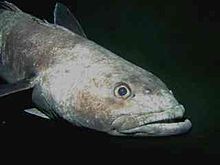- Antarctic cod
-
Antarctic toothfish, Antarctic cod 
Dissostichus mawsoni in McMurdo Sound Scientific classification Kingdom: Animalia Phylum: Chordata Class: Actinopterygii Order: Perciformes Family: Nototheniidae Genus: Dissostichus Species: D. mawsoni Binomial name Dissostichus mawsoni
Norman, 1937The Antarctic cod, or Antarctic toothfish, of the fish family Nototheniidae, is famous for producing antifreeze glycoprotein that allows it to survive in the ice-laden waters of the Southern Ocean surrounding Antarctica. With a heartbeat once every six seconds, research involving Antarctic toothfish may lead to advances in cardiac medicine involving conditions where human hearts beat slowly during certain medical procedures or fail to beat fast enough due to hypothermia.
The Antarctic cod is quite unrelated to a cod. It does not even belong in the same order. It is classified as a perciform rather than a gadiform.
These large fish are probably mesopelagic and have been caught in waters deeper than 2000 metres. Fully grown, these grayish fish are among the biggest in the Antarctic; adults of more than 2 metres in length and weighing over 135 kg (298 lbs) have been recorded during New Zealand research work carried out in the Ross Sea. The flesh is white with a high oil content. The taste is said to be similar to cod, which led to species sometimes being called Antarctic cod. They are closely related to, and sometimes confused with the Patagonian toothfish, Dissostichus eleginoides. Aging data collected during an ongoing CCAMLR tagging programme in the Ross Sea indicate Antarctic toothfish are relatively fast growing. They reach about 60 cm after five years, 1 meter after 10 years, and about 1.5 m at about 20 years. The maximum age recorded so far has been 48 years, with a maximum weight of 150 kg - there are few fish older than about 30 years caught in the fishery. Indications from this current research are that fish mature at about age 10.[1]
They are generally piscivorous (fish-eaters), but are known to eat almost anything, including the remains of penguins caught by seals and orca on the surface.[2] Stable isotope studies on Antarctic food webs by New Zealand scientists from the National Institute of Water and Atmospheric Research (NIWA) indicate Antarctic toothfish appear to occupy a similar trophic level in the Antarctic food web as orca and Weddell seals in McMurdo Sound, bluefin tuna in the Atlantic, and sperm whales from the Gulf of Mexico. Smaller juveniles may also be prey of the Weddell seal, the leopard seal, large squid, and orca.[3]
Antarctic toothfish have a lightweight, cartilaginous skeleton, lack a swim bladder, and have fatty deposits which may act as a stored energy source, particularly during spawning.[4] They also have retinas well adapted to the low light levels. Since snow and ice cover the surface of the ocean even in summer, their specialized eyes are evolved to work in the reduced light levels found in the great depths of the Antarctic ocean. Coloring is black to olive brown, sometimes lighter on the undersides, with a mottled pattern on the fins. They have a broad head, an elongated body with an extended bifurcate caudal fin, a long anal fin, large pectorial fins and a rudder-like caudal fin. Its distribution range is generally below latitude 60 degrees south. It is mainly caught in the Ross Sea in the austral summer but has also been recorded from Antarctic coastal waters south of the Indian Ocean sector, in the vicinity of the Antarctic peninsula, and near the South Sandwich Islands. Antarctic toothfish is managed by the Convention for the Conservation of Antarctic Marine Living Resources (CCAMLR), which has limited fishing to a precautionary catch level in the Ross Sea; fishing takes place with the aim of collecting sufficient biological and stock size information to effectively manage this fishery in the future.
Potential for unsustainable consumption
In 2010, Greenpeace International added the Antarctic cod to its seafood red list. "The Greenpeace International seafood red list is a list of fish that are commonly sold in supermarkets around the world, and which have a very high risk of being sourced from unsustainable fisheries."[5]
References
- ^ Dunn, A.; Horn, P.L.; Hanchet, S.M. (2006). Revised estimates of the biological parameters for Antarctic toothfish (Dissostichus mawsoni) in the Ross Sea. WG-FSA-SAM-06/08. 14 p. National Institute of Water and Atmospheric Research
- ^ Fenaughty, J.M., D.W. Stevens and S.M. Hanchet. 2003. Diet of the Antarctic toothfish (Dissostichus mawsoni) from the Ross Sea, Antarctica (Subarea 88.1). CCAMLR Science, 10: 113–123.
- ^ Pinkerton M.H., S. Bury, S.M. Hanchet and D. Thompson (National Institute of Water and Atmospheric Research ([NIWA]http://www.niwa.cri.nz/) Ltd, Stable isotope analysis of Southern Ocean fish tissue samples to investigate trophic linkages of Antarctic toothfish (Dissostichus mawsoni). 27 pp. CCAMLR Science, submitted (English). CCAMLR WG-EMM-07/19
- ^ Fenaughty, J.M., J.T. Eastman and B.D. Sidell. 2008. Biological implications of low condition factor “axe handle” specimens of the Antarctic toothfish, Dissostichus mawsoni, from the Ross Sea. Antarctic Science, 20: 537–551.
- ^ This assessment is contentious. Greenpeace International Seafood Red list
- "Dissostichus mawsoni". Integrated Taxonomic Information System. http://www.itis.gov/servlet/SingleRpt/SingleRpt?search_topic=TSN&search_value=642808. Retrieved 30 January 2006.
- Froese, Rainer, and Daniel Pauly, eds. (2005). "Dissostichus mawsoni" in FishBase. 10 2005 version.
- Philips, Matthew (August 21, 2007), "Squid Eats Toothfish", Newsweek, http://www.newsweek.com/id/36384/output/print[dead link]
Categories:- Fauna of Antarctica
- Nototheniidae
Wikimedia Foundation. 2010.
